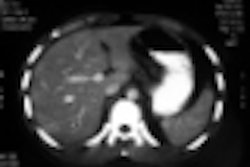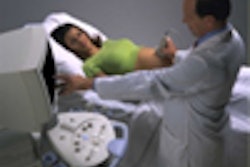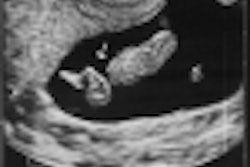(Ultrasound Review) An evaluation of the ultrasound features of spermatic cord hydrocele (SCH) in children was described in a study recently published in The British Journal of Radiology. Pediatric surgeons and radiologists from Tel-Aviv University combined their efforts in a retrospective study of children with SCH.
"Affected children usually present with a firm groin swelling, and ultrasound evaluation of the inguinal region is performed to exclude an incarcerated inguinal hernia, inguinal lymphadenopathy or an extratesticular tumor," the authors said.
Over a five-year period, 1743 children underwent ultrasound of the inguinal area using a high-frequency 7MHz linear array transducer. Twenty-seven children were shown to have SCH, but only one of these was suspected clinically. Clinically the boys were thought to have a variety of conditions including -- inguinal hernia (20), hydrocele (3), mass (2) and incarcerated inguinal hernia (1). Ultrasound demonstrated a well-defined oval anechoic lesion in every case. The masses were at the level of the groin, along the spermatic cord.
There were 24 children with encysted hydrocele, a fluid collection that has no communication with the peritoneum or the tunica vaginalis. Three children were shown to have funicular hydrocele, a fluid collection along the spermatic cord that communicated with the peritoneum at the internal ring. Surgery confirmed the ultrasound findings in 23 of the 27 children and the remainder, all with EH, were followed clinically.
According to the authors, two characteristics may be used to differentiate EH. Ultrasound showed that cases of EH had a loculated fluid collection and closed internal ring. However in this study there were six cases of EH that showed an open internal ring because of an associated indirect inguinal hernia. According to the authors "the ultrasound differential diagnosis between a funicular hydrocele and an indirect inguinal hernia may be difficult and sometimes impossible. A funicular hydrocele is considered as a potential indirect hernia and prophylactic surgery is usually performed, so differentiation between the two entities is of clinical importance."
They concluded "ultrasound examination is a very sensitive and accurate method for diagnosis of this entity and for exclusion of other lesions in this region."
"Ultrasound features of spermatic cord hydrocele in children"V Rathaus et al
Dept of Diagnostic Imaging, Sapir Medical Center, Tel-Aviv University, Tel-Aviv, Israel
The British Journal of Radiology, 2001(Sept); 74:818-820
By Ultrasound Review
November 6, 2001
Copyright © 2001 AuntMinnie.com



















